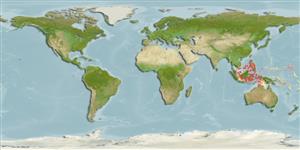>
Gobiiformes (Gobies) >
Gobiidae (Gobies) > Gobiinae
Etymology: Trimma: Greek, trimma, -atos = something crushed (Ref. 45335); corerefum: Name from the arbitrary combination of letters reflecting the Coral Reef ResearchFoundation in Palau and is pronounced 'core-ref-um'; an organization, established and operated by Pat and Lori Colin; noun in apposition..
Environment: milieu / climate zone / depth range / distribution range
Ecologie
marien; diepte 10 - 30 m (Ref. 109919), usually 12 - 30 m (Ref. 109919). Tropical
Verspreiding
Landen | FAO regio's | Ecosystemen | Voorkomen | Point map | Introducties | Faunafri
Western Pacific: Palau, Indonesia and the Philippines.
Grootte / Gewicht / Leeftijd
Maturity: Lm ? range ? - ? cm
Max length : 1.7 cm SL mannelijk / geslacht onbekend; (Ref. 109919); 1.9 cm SL (female)
Korte beschrijving
Morfologie | Morfometrie
Dorsale stekels (totaal): 7; Dorsale zachte stralen (totaal): 8; Anale stekels 1; Anale zachte stralen: 8. This species is distinguished by the following characters: possess a bony interorbital about three-quarters pupil diameter (68-85%), with a fully scaled nape, the anterior rows cycloid in adults, a second dorsal spine that usually reaches middle of the second dorsal fin; two cephalic sensory papillae in row f on the chin and in row r on the top of the snout, 2-5 (usually 4) papillae in row d? immediately behind the maxilla, usually 13 (range = 12-14) unbranched pectoral-fin rays, and an unbranched fifth pelvic-fin ray that is 34-45% the length of the fourth ray. Colour of freshly collected specimens: reddish head and anterior nape except below a line bounded by the horizontal limb of preopercle, where these are white; red opercular region and abdomen with a liberal sprinkling of large, dark brown melanophores, a pupil-diameter wide white band across peduncle anterior to the caudal spot, approximately pupil diameter dark marking on the posterior part of the peduncle and extending onto the bases of the caudal fin rays; preserved specimens with four distinct groupings of small round black melanophores situated at the 3, 4:30, 6 and 9 o’clock positions around the eye (Ref. 109919).
Occurs in vertical wall with small caves, overhangs and crevices, hard corals (<>iAcropora, Montipora), hydroids, and sea fans (Ref. 109919).
Levenscyclus en paargedrag
Maturiteit | Voortplanting | Paaien | Eieren | Fecunditeit | Larven
Winterbottom, R., 2016. Trimma tevegae and T. caudomaculatum revisited and redescribed (Acanthopterygii, Gobiidae), with descriptions of three new similar species from the western Pacific. Zootaxa 4144(1):001-053. (Ref. 109919)
Status op de Rode Lijst van het IUCN (Ref. 130435)
Gevaar voor de mens
Harmless
Gebruik door de mens
Meer informatie
Lokale namenSynoniemenMetabolismePredatorenEcotoxicologieVoortplantingMaturiteitPaaienPaaiaggregatiesFecunditeitEierenOntwikkeling van de eieren
Leeftijd/GrootteGroeiLengte-gewichtLengte-lengteLengtefrequentiesMorfometrieMorfologieLarvenLarvale populatiedynamiekRekruteringAbundantieBRUVS
ReferentiesAquacultuurAquacultuurprofielKweeklijnenGeneticaElectrophoresesErfelijkheidZiektesVerwerkingNutrientsMassaconversie
Tools
Speciale rapporten
Download XML
Internetbronnen
Estimates based on models
Fylogenetische diversiteitsindex (Ref.
82804): PD
50 = 0.5000 [Uniqueness, from 0.5 = low to 2.0 = high].
Bayesian length-weight: a=0.00708 (0.00333 - 0.01504), b=3.09 (2.92 - 3.26), in cm total length, based on LWR estimates for this (Sub)family-body shape (Ref.
93245).
Weerstandsvermogen (Ref.
120179): Hoog, minimale populatieverdubbelingstijd minder dan 15 maanden (Preliminary K or Fecundity.).
Fishing Vulnerability (Ref.
59153): Low vulnerability (10 of 100).
